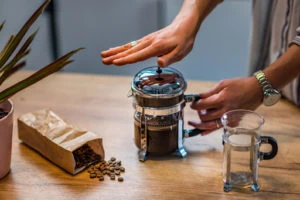When it comes to getting the most mileage out of your icing, it pays to know a thing or two about its shelf-life. So, how long does royal icing last and what can you do to waste as little as possible of a big ol’ batch?
Well, in general, a royal icing whipped up with meringue is pretty hardy from the get-go. It will last 2 weeks (with a little wiggle room) in an airtight container at room temperature, up to a month in your refrigerator, and approximately 3 months in your freezer.
Frozen and vacuum sealed, you might get 6 months or more of use, but after 6 months it’s really better just to make a fresh batch. If you are using pasteurized or farm-fresh eggs, then reduce your storage time by 50% for room temperature and 25% for your refrigerator, but it will stay the same for freezing and vacuum-sealed, frozen icing.
In today’s article, we’re going to explore getting the most out of your delicious royal icing so that you’ll have a better idea about your options and how to take advantage of them, and we’ll even throw in some useful tips along the way.
How long does royal icing keep? It all depends on how you store it and if you’re doing it right!
What is Royal Icing? – Understanding its shelf-life
Royal icing is something you’ve seen many times, most often on Christmas, and it’s just a hard icing that is basically made up of egg whites, confectioner’s sugar, and sometimes a little citrus flavoring from lemon or lime juice and added food coloring if you want some fancy decoration.
It’s often used in intricate designs on gingerbread houses and cookies, with a perfect consistency for piping bags. Whether you’re using leftover royal icing or starting from scratch, it’s crucial to understand its longevity.
Sometimes meringue is substituted for the egg whites and this can greatly enhance the shelf life and give you the same consistency that you need to make some amazing cookies or cakes.
To better understand its shelf life, we’ll show you the ingredients from two different, easy recipes and don’t worry – we’ll link those so that you can see the full recipe and tips.
An easy royal icing recipe typically involves fresh egg whites or powdered sugar, and achieving the right consistency can depend on how much water you add. It’s vital for craft stores and home bakers alike to understand how these components affect shelf life.
For an egg-white royal icing, we’re going to share John Kannell’s ingredients and for an easy meringue variety, we’ve got a recipe from Sally’s Baking Addiction. We’ll list the ingredients without going into the mixer steps, and identify the key factors for longevity that you need to consider.
For John Kannell’s egg-white based royal icing, you need the following 3 ingredients:
- 3 egg whites
- 1 lb of confectioner’s sugar
- 1 tsp of vanilla extract
For Sally’s easy meringue-based royal icing, you only need 3 ingredients as well (although a 4th option ingredient for either recipe is food coloring, just in case you want to get colorful. Sally’s royal icing recipe requires the following 3 ingredients:
- 4 cups of confectioner’s sugar
- 3 tbsp of meringue powder
- 9 to 10 tbsp of water
In both traditional royal icing recipes and this easy variant, achieving a stiff peak is essential. Whether you’re using a mixing bowl and hand mixer or a stand mixer with a paddle attachment, the process influences the icing’s stability over time.
So, from the basic recipes, you can see that the most perishable portions are the meringue powder and the eggs, as the other ingredients are basically sugar and flavorings. This brings us to an important preservation rule – Eggs in your royal icing will reduce the shelf-life time by 50% for room temperature or 25% less time in your refrigerator (not freezer) storage.
Of course, you also want to preserve the consistency of the icing as well that it gets from your stand mixer and its useful attachments or from hand mixing, and since that comes from air that you trap while whipping it up, if you want to vacuum seal it later you have to freeze it first or simply seal it without vacuuming (and we’ll talk more about that shortly!).
Now that you know the 2 ingredients that create a predictable baseline for storage time, let’s take a look at the storage options that you have at your disposal and what you can expect from each one.
What is the best way to store royal icing?
While one surefire way to get the most out of your icing is a good bench scraper, if you want to keep your excess icing then you need to know how to properly store it.
Depending on the recipe, you’ve got a few different storage options that you can use in order to extend the shelf-life or your royal icing. To give you a more complete answer, we’ll cover each of these and give you estimations for egg vs. meringue-based royal icings.
Let’s take a look!
Room temperature storage
When storing royal icing, whether it’s a thick icing for gingerbread houses or a thin royal icing for more delicate decorations, using the right storage containers is crucial. Even a piece of plastic wrap or damp paper towel can make a difference in maintaining the icing’s quality.
Royal icing is pretty hardy stuff, even when it’s stored at room temperature – provided that you store unused icing IMMEDIATELY in an airtight container, then meringue-royal icing can last for 2 weeks at room temperature and you’ve got a little ‘wiggle room’.
This is because some say it might last up to 4 weeks! While we don’t recommend that, to play it safe, we can say with 100% conviction that it should last at room temperature in a cool, dark place, for 2 weeks so it’s best to use that estimation.
For a royal icing that you’ve made with pasteurized or fresh eggs, you can get about 1 week of shelf-life before the icing will need to be thrown out.
Refrigerator
If you will be storing your royal frosting in an airtight container in your fridge, then you can get a pretty decent shelf life that will be sufficient for most. With a meringue powder royal icing, it should stay good for a month and maybe a little bit over that – but we don’t recommend pushing it.
As the rule goes, you’ll get 25% less storage time if you used fresh eggs in your recipe, and so you can count on it lasting up to 3 weeks in your refrigerator.
Frosting is delicious, so you’ll seldom need longer storage time, but let’s look at your freezing options just in case you WANT it so you can save a little time later.
Freezer
Freezing will get you an excellent boost to your shelf life, with a meringue powder icing lasting up to 3 months, and one that you’ve made with eggs should last at least 2.
Some bakers prefer sandwich bags or parchment paper for storing different consistencies of royal icing. For flood consistency icing, it’s important to minimize air bubbles, which can be achieved by mixing on medium-low speed.
The best way to go about this is to place your frosting inside a large Ziploc sealable bag and then you’ll want to close it most of the way, but leave enough of an opening so that you can squeeze out the excess air. We should not use food coloring tends to bleed, so it’s a good idea to freeze it white.
You don’t have to, but if the color bleeds then be sure that you have some extra food coloring handy, as you’re going to need to correct the color when you thaw it.
Also, when you freeze royal icing, make sure that it isn’t dry – dry icing tends to crumble and won’t freeze well, so a tablespoon of water might be a good idea.
Vacuum sealing
Vacuum sealing will get you the longest shelf life (and you can even use it just to seal the frosting before freezing, provided you ONLY seal it and not initiate the vacuum process. Now, for extending the life through vacuuming sealing, you simply need to freeze it first.
By freezing the frosting, you can put it in a vacuum seal bag and you won’t have to worry about what might otherwise happen if you attempted to seal an air-fluffed icing. This should give you up to 6 months (and possibly up to a year!) shelf life for a meringue-based icing.
With an egg-based one, shave off 25%, and you can expect a 4.5 month shelf life with a frozen, then vacuum sealed royal icing.
While we are sharing this method as a means to really supercharge your shelf-life, it’s really a bit of overkill, as you can whip up a fresh batch with 5 minutes of preparation time. Still, a little extra knowledge never hurts, so file it away in case you need it someday!
How do you know when royal icing has gone bad?
Thankfully, if your royal icing has gone bad, it’s pretty easy to tell.
For cookie decorators, especially those working on gingerbread cookies or gingerbread men, noticing changes in the royal icing taste or the glossy finish at the edge of the cookie is a sign of spoilage. Royal icing, when stored correctly, should maintain its white icing appearance without dark colors or disintegration.
Here are a few telltale signs to look for so that you’ll know right away if it’s time to mix up a new batch:
- Consistency – When bacteria starts feasting on your frosting, it’s going to puff up quite a bit in response and that’s a definite red flag that you’ll need to mix a new batch. That said, even just small changes in the consistency might be a good time to throw it out – improperly stored or icing that’s been stored too long often gets flaky and hard to work with. Get rid of that and start over!
- Smell – While some commercial royal icing has a kind of ‘wet dog’ smell to it and with homemade icing the food colorings have their own distinctive scents, if you smell something sour then it’s time to remix your royal icing. You’ll get used to the food coloring scents and if you sniff your icing before storage, you’ll learn the exact smell and it’s an important thing to do – if it ever smells sour or even a little weird, then it’s time to chunk it and make more!
- Discoloration – Food coloring will bleed if you freeze it, so that doesn’t count for spoilage, but any colors that you see that you didn’t put there (especially blues, greens, blacks, or browns) are a surefire indicator that your icing has gone caput – just invest 5 minutes and make more, as food poisoning definitely isn’t worth saving so little time!
In this comprehensive guide to storing royal icing, we’ve covered everything from the basic recipe to tips for first-time bakers. Whether you’re using confectioners’ sugar or lemon juice in your recipe, understanding storage is key.
FAQs
It’s almost time for us to wrap things up, but before we do that, we’ve collected a few frequently asked questions on royal icing and how long it lasts that we think you might find useful. Let’s take a look and then we’ll get to formally ‘closing out shop’ for the day!
How far in advance can I make royal icing?
Royal icing is pretty durable stuff and if you want to make it in advance, we recommend doing it a week before you need it and storing it in an airtight container in your refrigerator. After only a week’s time, it will still taste fresh and yummy and you’ll have it ready to go when you need it.
If you will be storing colored frosting, one useful trick is to add a little white gel to the base, as this will help to reduce the chances of your color bleeding if it’s highly saturated with food coloring, or you could simply just store it white and mix the colors when it’s time to put the icing on – your call!
How long do sugar cookies last with royal icing?
If you want to store cookies that you’ve already decorated with royal icing, the hardened icing should last for up to 3 to 4 weeks if you are just storing the cookies in an airtight container in a cool, dry place. If you want to stick them in the fridge, make sure that you put them in an airtight container first.
That’s because refrigerators have about 65% humidity inside and because of this, if you pile up Christmas cookies on a plate then you’re very likely to get some bleeding color. This can also affect the aesthetics of sugar cookies, so be sure to use an airtight container if you stick them in the fridge.
Decorated cookies, particularly those with long royal icing embellishments or a little royal icing detail, should be stored with care. If you’re making holiday cookies or sugar cookie recipe treats, the storage technique can affect their longevity.
Has my royal icing gone bad if it cracked on my cookies?
If you’ve iced some cookies or a fruit cake and it looks a bit uneven, wavy, or even has some noticeable cracks, then the most likely explanation is that you moved the items before the icing could fully dry.
You can also get this if you put them in front of a fan, as they dry too fast or the air simply pushes them around enough to affect the finished shape. As a general rule, once you’ve applied royal icing, you want to let it dry undisturbed and away from humidity as much as possible for best results.
In Conclusion
Today we’ve answered the question ‘how long does royal icing keep?’ and the answer really depends on how you decide to store it and whether you’ve substituted meringue for the eggs in your recipe.
Meringue lasts the longest, with a 2 week shelf life in an airtight container at room temperature, and a month in the refrigerator, 3 months in the freezer, or 6 months or more if frozen and vacuum sealed.
By contrast, if you have an egg-based royal icing, you’ll want to shave off 50% of shelf life for room-temperature storage and 25% off of storage time in your refrigerator – so you get a week of room-temperature storage and about 3 weeks in the refrigerator.
The frozen, egg-based royal icing will last 2 months in your freezer, unless you freeze and vacuum seal it, in which case you’re looking at 4.5 months but really, that’s a bit of overkill. As you can make it fresh in much less time than it would take you to freeze and vacuum seal it, why not just make a new batch?!
We’ve explored different ways to extend the shelf life of royal icing, from using fresh egg whites to adding lemon juice or gel food coloring. Remember, the only thing that matters is keeping your iced cookies and royal icing creations fresh and appealing for as long as possible.
We hope that you’ve enjoyed our exploration of royal icing shelf-life and until next time, we wish you and yours the very best!





